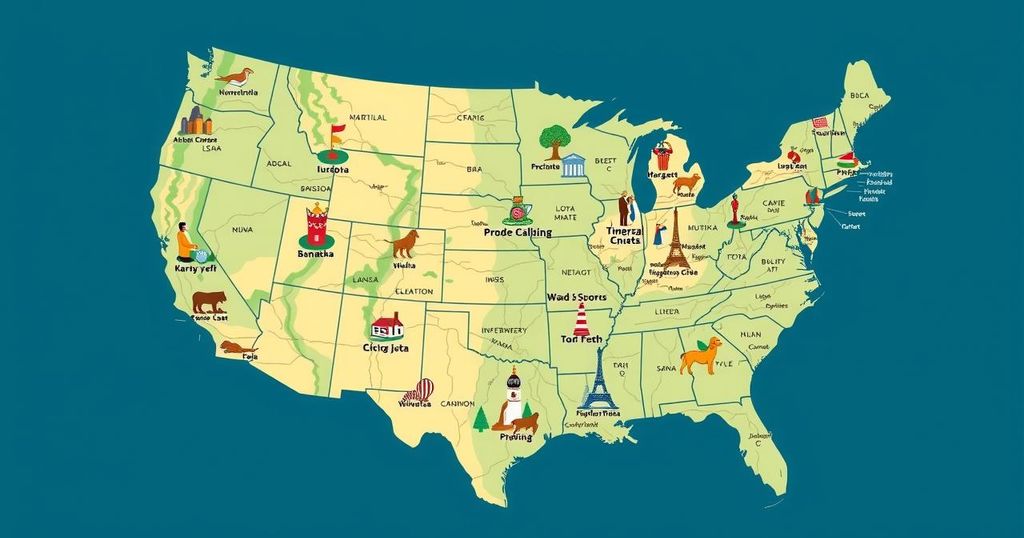US Election 2024: An Overview of America in 20 Maps

Ahead of the upcoming 2024 US elections, 20 maps illustrate the nation’s socio-economic landscape, highlighting key indicators such as GDP, unemployment rates, racial demographics, minimum wage variations, and the prevalence of homelessness. California, Texas, and New York demonstrate significant economic power while states exhibit varying minimum wage standards. Issues of immigration, youth voting, maternal mortality rates, and crime underscore complexities that influence electoral behavior. As America approaches the elections, understanding these statistics is essential for comprehending voter motivations and societal challenges.
As the United States approaches the pivotal elections on November 5, 2024, a comprehensive overview of the nation, conveyed through 20 informative maps, elucidates various socio-economic indicators. The following insights reveal critical aspects of the economy, demographics, geography, and historical context that shape voter perspectives and preferences. Presently, the United States exhibits a Gross Domestic Product (GDP) of approximately $29 trillion, with key economic powerhouses such as California, Texas, and New York contributing significantly at $4.8 trillion, $2.9 trillion, and $2.3 trillion respectively. Unemployment rates vary by state, prominently featuring the District of Columbia with a rate of 5.7 percent, while South Dakota boasts a commendably low rate of 2 percent. As the national conversation increasingly focuses on economic conditions, approximately 80 percent of registered voters identified the economy as a pivotal factor influencing their electoral decisions. In a similar vein, again reflective of economic discontent, the debate surrounding the minimum wage, currently at $7.25 per hour federally, continues with calls for an increase – heavily advocated by Democratic leaders like Kamala Harris. Income taxation also draws scrutiny, with California leading at a rate of 13.3 percent for its wealthiest residents, in contrast to states such as Alaska and Nevada which impose no state income tax. The growing issue of homelessness bears dire implications, revealing a national rate of 20 homeless individuals per 10,000 people, disproportionately concentrated in urban hotspots such as New York and D.C. The presence of affluent individuals in the United States is notable, with billionaires such as Elon Musk and Jeff Bezos residing in Texas and Florida, respectively. Spatially, the U.S. encompasses about 9.8 million square kilometers, making it the world’s third-largest nation, with California housing the densest population, meanwhile Wyoming stands as the least populated state. Immigration remains a contentious topic, with a significant proportion of residents in states like California (27 percent) born outside the United States, a key consideration among voters. The racial and ethnic makeup of the country is evolving as noted by the 2020 Census, revealing that 57.8 percent identify as White non-Hispanic, an observable decrease from previous decades. The demographic analysis extends to youth voting trends, wherein states like Utah demonstrate considerable engagement from younger voters, while maternal mortality rates present sobering statistics, particularly pronounced in states such as Arkansas. Reports also indicate the violent crime rates are elevated in locales such as the District of Columbia. Moreover, the issue of mass shootings persists, with Illinois being the state with the most recorded incidents between 2014 and 2023. The landscape of capital punishment is complex, with 21 states enforcing death penalties while 23 have abolished it entirely. The 2022 Supreme Court ruling to revoke the reproductive rights provided by Roe v. Wade introduced additional layers of complexity regarding abortion access across various states. Lastly, the historical evolution of statehood in the U.S. culminated with Alaska and Hawaii becoming the last additions in 1959.
The United States’ dynamic political landscape is informed by varying socio-economic conditions across its states, contributing to the discourse surrounding the 2024 elections. With an overarching focus on economic stability, income equity, immigration policies, and social justice issues—these maps provide clarity on current trends and challenges facing the nation. Particularly, mapping the unemployment rates, minimum wage discrepancies, and other indicators sheds light on how these elements impact voter sentiment and political platforms in a deeply divided electorate, underlining the significance of geography and demographics within electoral outcomes.
In conclusion, the analysis through 20 maps serves as a valuable visualization of the multifaceted issues permeating the United States as it heads toward the 2024 elections. From economic indicators and demographics to social challenges like homelessness and crime, understanding these dimensions is imperative for stakeholders within the political arena. The upcoming elections will likely reflect these considerable disparities, thus shaping the future trajectory of American polity and society. Understanding these underlying factors will be pivotal for voters, candidates, and policymakers alike in navigating the complexities of the American electoral landscape.
Original Source: www.aljazeera.com








